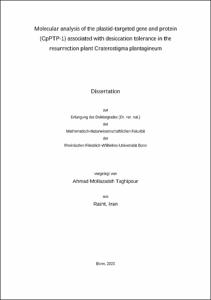Mollazadeh Taghipour, Ahmad: Molecular analysis of the plastid-targeted gene and protein (CpPTP-1) associated with desiccation tolerance in the resurrection plant Craterostigma plantagineum. - Bonn, 2021. - Dissertation, Rheinische Friedrich-Wilhelms-Universität Bonn.
Online-Ausgabe in bonndoc: https://nbn-resolving.org/urn:nbn:de:hbz:5-61071
Online-Ausgabe in bonndoc: https://nbn-resolving.org/urn:nbn:de:hbz:5-61071
@phdthesis{handle:20.500.11811/8902,
urn: https://nbn-resolving.org/urn:nbn:de:hbz:5-61071,
author = {{Ahmad Mollazadeh Taghipour}},
title = {Molecular analysis of the plastid-targeted gene and protein (CpPTP-1) associated with desiccation tolerance in the resurrection plant Craterostigma plantagineum},
school = {Rheinische Friedrich-Wilhelms-Universität Bonn},
year = 2021,
month = jan,
note = {Water scarcity causes drought stress and enormous losses in agricultural production, and consequently this leads to a worldwide food crisis. Craterostigma plantagineumis one of the best studied resurrection plants that is able to adapt to water scarcity and survive under severe drought stress conditions (desiccation). This plant has been widely studied to understand the molecular basis of desiccation tolerance. The study of the genes and their corresponding proteins related to desiccation tolerance may help to improve tolerance of sensitive plants, particularly crops.
In the present study, an ABA and desiccation-induced gene from C. plantagineumcalled CpPTP-1which belongs to a plastid-targeted protein (PTP) family was investigated. This study was carried out to have a better understanding of the role of the CpPTP-1 protein in acquisition of desiccation tolerance in C. Plantagineum.
Promoter regions and corresponding regulatory cis-acting elements of the CpPTP-1gene were studied to understand and identify the motifs involved in the regulation of gene expression at the transcriptional level as the most important step in the activation and the suppression of gene expression. It is observed that a combination of cis-acting elements including coupling element 3 (CE3), MYC and dehydration-responsive element (DRE) regulate the full activity of CpPTP-1during abiotic stress. The MYC motif which is a binding site for NAC transcription factors showed a great effect on the regulation of expression of the CpPTP-1 gene in C. plantagineum. The promoter of the CpPTP-1gene exhibited high activity in stably transformed A. thalianaplants in both stress conditions and non-stress conditions.
The CpPTP-1 unlike any other plant protein uniquely contains a bacterial receptor domain called Methyl-accepting chemotaxis-like conserved domain (MCP) which mediates chemotaxis to different environmental and intracellular signals in bacteria and archaea.
In this work, a protein-protein interaction (PPI) study was performed to understand the function of the CpPTP-1 protein during desiccation. A yeast two-hybrid screening approach revealed that the CpPTP-1 protein interacts with a chloroplastic lipocalin (CpCHL) protein in yeast, suggesting the same interaction in C. plantagineum. The interaction between those proteins is mediated by two coiled-coil domains of the CpPTP-1 protein. The transcript of the CpCHLis highly up-regulated upon desiccation. The CpCHL protein is localized in the chloroplasts of C. plantagineum. On the basis of the CpCHL cellular function, the findings of this study suggest that the CpPTP-1 and CpCHL proteins form a functional complex to protect the photosynthesis apparatus in chloroplasts during desiccation by preventing lipid peroxidation of thylakoid membrane lipids of chloroplasts.},
url = {https://hdl.handle.net/20.500.11811/8902}
}
urn: https://nbn-resolving.org/urn:nbn:de:hbz:5-61071,
author = {{Ahmad Mollazadeh Taghipour}},
title = {Molecular analysis of the plastid-targeted gene and protein (CpPTP-1) associated with desiccation tolerance in the resurrection plant Craterostigma plantagineum},
school = {Rheinische Friedrich-Wilhelms-Universität Bonn},
year = 2021,
month = jan,
note = {Water scarcity causes drought stress and enormous losses in agricultural production, and consequently this leads to a worldwide food crisis. Craterostigma plantagineumis one of the best studied resurrection plants that is able to adapt to water scarcity and survive under severe drought stress conditions (desiccation). This plant has been widely studied to understand the molecular basis of desiccation tolerance. The study of the genes and their corresponding proteins related to desiccation tolerance may help to improve tolerance of sensitive plants, particularly crops.
In the present study, an ABA and desiccation-induced gene from C. plantagineumcalled CpPTP-1which belongs to a plastid-targeted protein (PTP) family was investigated. This study was carried out to have a better understanding of the role of the CpPTP-1 protein in acquisition of desiccation tolerance in C. Plantagineum.
Promoter regions and corresponding regulatory cis-acting elements of the CpPTP-1gene were studied to understand and identify the motifs involved in the regulation of gene expression at the transcriptional level as the most important step in the activation and the suppression of gene expression. It is observed that a combination of cis-acting elements including coupling element 3 (CE3), MYC and dehydration-responsive element (DRE) regulate the full activity of CpPTP-1during abiotic stress. The MYC motif which is a binding site for NAC transcription factors showed a great effect on the regulation of expression of the CpPTP-1 gene in C. plantagineum. The promoter of the CpPTP-1gene exhibited high activity in stably transformed A. thalianaplants in both stress conditions and non-stress conditions.
The CpPTP-1 unlike any other plant protein uniquely contains a bacterial receptor domain called Methyl-accepting chemotaxis-like conserved domain (MCP) which mediates chemotaxis to different environmental and intracellular signals in bacteria and archaea.
In this work, a protein-protein interaction (PPI) study was performed to understand the function of the CpPTP-1 protein during desiccation. A yeast two-hybrid screening approach revealed that the CpPTP-1 protein interacts with a chloroplastic lipocalin (CpCHL) protein in yeast, suggesting the same interaction in C. plantagineum. The interaction between those proteins is mediated by two coiled-coil domains of the CpPTP-1 protein. The transcript of the CpCHLis highly up-regulated upon desiccation. The CpCHL protein is localized in the chloroplasts of C. plantagineum. On the basis of the CpCHL cellular function, the findings of this study suggest that the CpPTP-1 and CpCHL proteins form a functional complex to protect the photosynthesis apparatus in chloroplasts during desiccation by preventing lipid peroxidation of thylakoid membrane lipids of chloroplasts.},
url = {https://hdl.handle.net/20.500.11811/8902}
}






